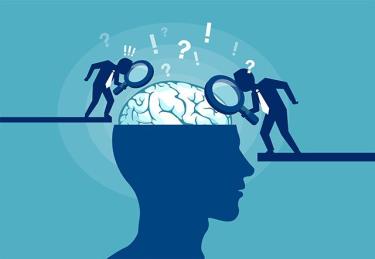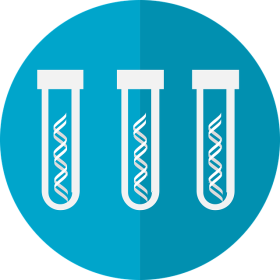Explore these snapshots of current research at the UW Alzheimer's Disease Research Center, spanning findings in genetics, neuropsychology, caregiving, and biomarker discovery. These studies benefited from UW ADRC resources or used data from research participants in the UW ADRC Clinical Core or the Adult Changes in Thought Study. This research was made possible in part by funding from the National Institute on Aging, grant AG066509.
Genetics
Aberrant splicing of PSEN2, but not PSEN1, in individuals with sporadic Alzheimer's disease. Course MM et al. Brain. August, 2022// Meredith Course, Kathryn Gudsnuk, C. Dirk Keene, Thomas Bird, Suman Jayadev, and Paul N. Valdmanis.

NIH
Pathogenic gene variants in PSEN1 and PSEN2 are rare causes of familial Alzheimer’s disease. UW researchers now have reason to think that these genes also hold clues to cases of the more common late-onset ‘sporadic’ Alzheimer’s disease. Recent work from a UW team, including UW ADRC researchers, found that age-related changes in the way PSEN2 generates transcripts (instructions for making proteins) might be involved in sporadic Alzheimer’s risk in the general population.
The team has since worked to identify these flawed recipes for proteins in Alzheimer’s pathology. “This project is exciting,” says study author Paul Valdmanis, assistant professor of medical genetics in the UW Department of Medicine, because “we could provide insight into why individuals develop Alzheimer’s disease without a family history of disease.”
In a new study published in Brain, the team characterized novel PSEN1 and PSEN2 transcripts in samples from cases of both familial and sporadic Alzheimer’s disease from the UW ADRC and compared these against healthy controls from the ACT Study. They leveraged PacBio Iso-Seq—a third-generation sequencing method for obtaining long reads of transcripts.
The team found certain abnormal splice products of PSEN2 only in late-onset sporadic Alzheimer’s disease samples. This finding suggests that genetic transcript differences in PSEN2 may play a role in Alzheimer’s disease in the general population.
“What really surprised us was that individuals with pathogenic variants in PSEN1 or PSEN2 did NOT share the same high level of abnormal splice products in PSEN2 as individuals with late-onset sporadic disease. We have reason to believe that this is because these familial cases might already have a genetic hit that causes Alzheimer’s disease.”
The researchers see this finding as a first step towards discovering new ways to preserve genetic function as a possible future treatment. This work was supported, in part, by a UW ADRC development project grant awarded to Meredith Course, PhD and by the UW ADRC Neuropathology Core.
Neuropsychology
Cognitive domain harmonization and co-calibration in studies of older adults. Mukherjee S, et al. Neuropsychology, Aug. 2022. // Shubhabrata Mukherjee, Seo-Eun Choi, Michael L Lee , Phoebe Scollard, Emily H Trittschuh, Jesse Mez, Andrew J Saykin, Laura E Gibbons, R Elizabeth Sanders, Walter A Kukull, Andrea Z Lacroix, Eric B Larson, Paul K Crane

UW Medicine/Getty
In large, long-running studies of older adults, such as the Adult Changes in Thought (ACT) Study (participants = 5,546) and the Rush Memory and Aging Project (participants = 2,163), participants attend regular research visits over time and undergo different procedures including tests of thinking and memory. These studies generate large amounts of data that researchers can use to find associations between lifestyle or genetic factors and late-life cognitive functioning and impairment.
However, the specific types of memory and thinking tests that researchers used tend to vary from study to study. This lack of standardization across studies makes it difficult for researchers to compare individual results when using data pooled from multiple studies.
In what Paul Crane, MD, MPH, professor of medicine at the UW School of Medicine, calls a ‘Hello World” methods paper, a UW team shares the results of a major effort to make it easier for researchers to leverage data from multiple studies of older adults. They have succeeded in taking the cognitive test scores from 10 different studies and calibrating them according to the same metric. “What that means,” says Crane, “is that the scores from each study are now directly comparable to one another; they mean the same thing about a participant’s performance. So, if a person in Study A had been evaluated and studied in Study B, this person would be expected to have the same score.”
These calibrated test scores for 10 different study datasets have many benefits to the Alzheimer’s field. A researcher can focus on their important scientific question without having to spend as much valuable time manipulating statistics. “Our science is really benefiting a lot from the recent moves towards data sharing and data availability,’ says Crane. “Our group is doing the work to make it so that those shared data are amenable to quick scientific analyses of relationships between cognition and whatever else is of interest, across multiple different datasets—and without anyone else needing to worry about the details that we worry about.”
The team is currently working to generate these co-calibrated memory scores for datasets from the UW ADRC Clinical Core, to make their participants’ data even more easily accessible to other researchers across the country.
This effort is part of the NIH-funded Alzheimer’s Disease Sequencing Project Phenotype Harmonization Consortium, a collaboration of four institutions attempting to pool data from 30+ research cohorts using data harmonization methods. The types of data include cognitive performance, genetics, neuroimaging, biomarker data, and autopsy neuropathology data. The goal of the Consortium is to produce a large-scale, racially diverse, standardized set of transparently defined data that will open new windows into the genetic basis of Alzheimer’s disease and resiliency.
Crane, who co-leads the cognitive data harmonization arm of this NIH Consortium, thinks that this larger data harmonization approach will ultimately lead to more confidence in scientific results in the Alzheimer’s field because researchers can check if an association found in one study can be confirmed in a different dataset.
Alzheimer’s Plasma Biomarker Tests
SOBA: Development and testing of a soluble oligomer binding assay for detection of amyloidogenic toxic oligomers. Shea et al. Proceedings of the National Academy of Sciences USA, December 2022 // Dylan Shea, Elizabeth Colasurdo, Alec Smith, Courtnie Paschall, Suman Jayadev, C Dirk Keene, Andrew Ko, Ge Li, Elaine Peskind, Valerie Daggett

In the earliest stages of Alzheimer’s disease, the brain forms toxic aggregates, called oligomers, of the protein amyloid beta. These oligomers can start to form more than a decade before symptoms begin to present and before any other known disease markers develop. The ability to detect these oligomers could help medical providers detect and diagnose Alzheimer’s disease much earlier, impacting course of treatment and staving off irreversible progression.
An NIH-funded research team, led by Valerie Daggett, professor of bioengineering at the University of Washington, in collaboration with ADRC researchers, created a synthetic molecule capable of selectively binding to toxic forms of amyloid beta, but not its non-toxic counterparts. From this molecule, called AP193, they developed an assay method to detect toxic amyloid beta in patients’ blood. This assay, called the soluble oligomer-binding assay (SOBA), was used on nearly 400 banked human blood plasma samples from UW ADRC research participants. These participants were categorized into the following groups: a control group of individuals with no known cognitive impairment, a group with mild cognitive impairment (or MCI), a group with Alzheimer’s disease, and a group carrying other forms of cognitive impairment.
SOBA ultimately detected the presence of toxic oligomers in 52 out of 53 people in the Alzheimer’s disease and MCI groups.
As expected, the blood test did not detect oligomers in most of the samples of control subjects who had no cognitive impairment. However, SOBA detected oligomers in 11 controls, and 10 of these positive samples came from people who later developed MCI. This finding shows that the SOBA test detected the toxic oligomers of amyloid beta before Alzheimer’s symptoms appeared. The researchers suggest that SOBA could form the basis for early diagnostic tests.
“We believe that SOBA could aid in identifying individuals at risk or incubating the disease,” Daggett says, “as well as serve as a readout of therapeutic efficacy to aid in development of early treatments for Alzheimer’s disease.” Daggett has a startup company working on this promising platform for early diagnosis and treatment of Alzheimer’s. To hear Daggett present about the technology and collaborations driving this work, check out the 2022 UW Engineering Lecture Series. Adapted from NIH Research Matters
Caregiving
Virtual Intervention for Caregivers of Persons With Lewy Body Dementia: Pilot Quasi-Experimental Single-Arm Study. Zaslavsky et al. JMIR Formative Research, July 2022 // Oleg Zaslavsky, Jasmine Kaneshiro, Frances Chu, Andrew Teng, Kimiko Domoto-Reilly , Annie T Chen
A team of researchers from the UW School of Nursing and UW Medicine recently completed a pilot evaluation of a digital intervention designed to help support caregivers of people with Lewy body dementia. The primary goal of this intervention, called Virtual Online Communities for Aging Life Experience-Lewy Body Dementia (or VOCALE-LBD), is to promote resilience and reduce stress in this vital population.
The Lewy body dementias, a term referring to both dementia with Lewy bodies and Parkinson’s disease dementia, are the second most common type of dementia in older adults. People with Lewy body disease often develop disruptive behaviors and sleep problems that can make caregiving particularly challenging. Compared to other types of dementia, caregivers of people with Lewy body dementia tend to report relatively higher levels of stress and more severe depressive symptoms.
With help from the UW ADRC, the research team recruited 15 family caregivers of people living with Lewy body dementia to participate. VOCALE-LBD is an 8-week interventional program conducted over a web-based discussion platform (that is moderated by study staff) and designed to enable peer-to-peer support, education, training, and problem-solving skill practice.
In the study, many caregivers reported that participation in VOCALE-LBD helped them better understand the disease, feel more confident in dealing with difficult behaviors, and improve their ability to care for their loved one. If validated in future studies, the intervention could become a valuable resource for caregivers, helping them to develop crucial inter-personal support networks without having to leave their homes. The team is now looking for informal caregivers of people with Lewy body dementia to participate in the next step of this project: conducting virtual focus groups and usability testing sessions. If you are interested in learning more or participating, please visit this VOCALE-LBD webpage.
*Only UW/ACT researchers listed in author lists.






